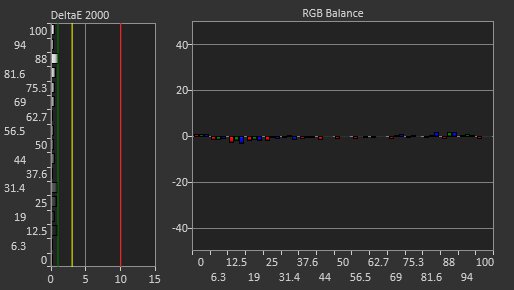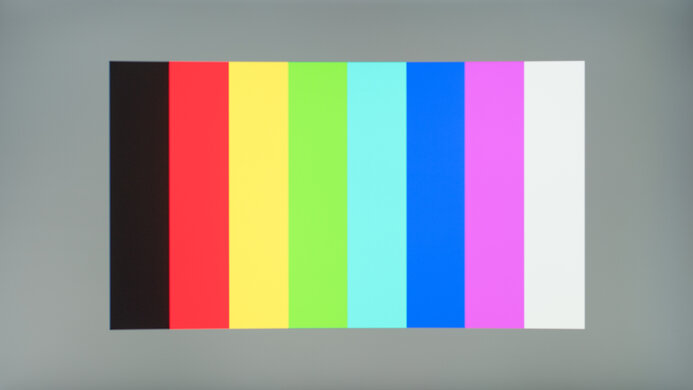Our Verdict
The MSI Optix G27C4 is a decent monitor for most uses. It can deliver a good picture quality, but its 1080p resolution is a bit low for a 27 inch screen, which is less ideal for multitasking. It's a great gaming monitor, though, as it has a 165Hz refresh rate, excellent response time, and a low input lag to provide a smooth and responsive gaming experience. Additionally, it supports FreeSync variable refresh rate to reduce screen tearing.
- Great contrast ratio.
- Outstanding gray uniformity.
- Bad ergonomics.
- Poor viewing angles.
The MSI Optix G27C4 is an okay monitor for office use. It has a large 27 inch screen to let you work comfortably, but text may not look as sharp due to its 1080p resolution. Viewing angles are rather poor, and the monitor's bad ergonomics make it hard to adjust to your optimal viewing position. The monitor has good reflection handling, but its low peak brightness may be an issue if you're in a bright room with direct sunlight.
The MSI Optix G27C4 is a great gaming monitor. It has a high refresh rate and a low response time to provide a smooth gaming experience. Input lag is exceptional and there's support for FreeSync variable refresh rate, but unfortunately, its 1080p resolution may be a bit disappointing for fans of RPGs and atmospheric games.
The MSI Optix G27C4 is an okay monitor for media consumption. Its 1080p resolution is a bit low, but its 27 inch screen lets you see comfortably without having to sit up close. Viewing angles may be a problem if you want to share content with others, and even though it has great reflection handling, viewing the screen in a bright room can be difficult due to the monitor's low peak brightness.
The MSI Optix G27C4 is an acceptable monitor for media creation. Its 27 inch screen provides plenty of screen real estate to work comfortably, but the 1080p resolution may be too low for content creators. The monitor has bad ergonomics, making it difficult to adjust to your optimal position, and the VA panel's viewing angles are poor, causing colors to appear washed out when viewed from the side.
The MSI Optix G27C4 is a sub-par monitor for HDR gaming. Although it has a high refresh rate, low response time, and low input lag, this monitor doesn't support any HDR format. In addition, its low peak brightness can't bring out any highlights. Its high contrast ratio is great for dark room gaming, though, as blacks look deep and inky.
Changelog
- Updated Jul 04, 2022: There was a mistake in the 60Hz input lag results. We remeasured the input lag at 60Hz, and it's 0.5ms higher than our original results.
- Updated Feb 07, 2022: Retested the weight, thickness, reflections, and image retention.
- Updated Jan 20, 2021: For consistency, we've changed the height adjustment from N/A to 'No'. The score has been adjusted accordingly.
- Updated Feb 21, 2020: Review published.
Check Price
Differences Between Sizes And Variants
We tested the MSI Optix G27C4, but there are three other variants with different screen sizes, resolutions, and refresh rates, which you can see in the table below.
| Model | Size | Resolution | Refresh Rate |
|---|---|---|---|
| MSI Optix G24C4 | 23.6" | 1080p | 144Hz |
| MSI Optix G27C4 | 27" | 1080p | 165Hz |
| MSI Optix G27CQ4 | 27" | 1440p | 165Hz |
| MSI Optix G32C4 | 31.5" | 1440p | 165Hz |
If someone comes across a different type of panel, or if their MSI Optix G27C4 doesn't correspond to our review, let us know and we'll update the review. Note that some tests, such as the gray uniformity, may vary between individual units.
Our unit of the MSI Optix G27C4 was manufactured in August 2019 and you can see the label here.
Popular Monitor Comparisons
The MSI Optix G27C4 is very similar to the MSI Optix G27C, with an updated design and a more aggressive screen curve. Its performance should be good enough for most gamers, but its ergonomics are very disappointing when compared to a monitor such as the ASUS VG279Q, and it doesn't have as many features as the Gigabyte Aorus FI27Q.
For other options, you can see our recommendations for the best gaming monitors, the best 1080p monitors, and the best 144Hz monitors.
The MSI Optix G27C4 is better than the MSI Optix G27C. The G27C4 is a somewhat updated version of the G27C with an updated design and some performance improvements. The G27C4 has a much better black uniformity, a higher refresh rate, and a faster response time. However, its peak brightness is lower, and its horizontal viewing angles are worse than the G27C. Gray uniformity is much better on the G27C4, as well as its out of the box color accuracy.
The Dell Alienware AW2720HF is significantly better than the MSI Optix G27C4. The Dell has an IPS panel with wider viewing angles and better color accuracy, as well as a higher refresh rate and faster response time. However, the MSI has a VA panel with much better contrast ratio and black uniformity, though the latter is still poor.
The Acer Nitro XF252Q Xbmiiprzx is better than the MSI Optix G27C4 for most uses. The XF252Q has a higher refresh rate of 240Hz and its ergonomics are significantly better. The XF252Q also has a faster response time, much better peak brightness, and it supports HDR. However, the G27C4 has a much better contrast ratio for dark room gaming, and its gray uniformity is also much better, with no visible dirty screen effect.
The LG 27GL650F-B is much better than the MSI Optix G27C4. Although the 27GL650F-B doesn't have as high a refresh rate as the G27C4, its IPS panel has much better viewing angles, significantly better peak brightness, and better color accuracy. The 27GL650F-B also supports HDR and has better ergonomics, but its contrast ratio is much worse than the G27C4, and it has a slightly higher input lag.

We buy and test more than 30 monitors each year, with units that we buy completely on our own, without any cherry-picked units or samples. We put a lot into each unbiased, straight-to-the-point review, and there's a whole process from purchasing to publishing, involving multiple teams and people. We do more than just use the monitor for a week; we use specialized and custom tools to measure various aspects with objective data-based results. We also consider multiple factors before making any recommendations, including the monitor's cost, its performance against the competition, and whether or not it's easy to find.
Test Results

Update 2/7/2022: The weight measurements were incorrect.
The MSI Optix G27C4 has a very simple design. It's mainly made out of matte black plastic. The top and side bezels are thin, but the bottom bezel is much thicker. The stand has a tripod design with a shorter back leg, and the screen is curved.
The stand has a tripod design, though the back leg is much shorter than the front legs. The overall footprint is large, but because the legs are thin, you can still use the space in-between the legs. The stand supports the monitor well and it doesn't wobble at all. If you prefer a similar monitor with a stand that sits flat against the table, then check out the MSI Optix G27C5.
Update 01/20/2021: For consistency, we've changed the height adjustment from N/A to 'No'. The score has been adjusted accordingly.
The MSI Optix G27C4 has bad ergonomics. It only allows for tilt adjustments. If you want a monitor with better ergonomics, take a look at the ASUS TUF Gaming VG259QM.
The back of the monitor is plastic and has a subtle gamer-oriented design, though it shouldn't look out of place in an office environment. The inputs are easy to access; however, there's no built-in cable management, and the stand doesn't have a quick release feature. There's a joystick at the bottom left corner to navigate the on-screen menu.
This monitor doesn't have a local dimming feature; the video above is provided for reference only.
SDR peak brightness is decent. There's almost no variation in brightness when viewing different content, and it should be bright enough for most well-lit rooms, though it may struggle a bit in direct sunlight. If you're looking for a similar monitor that gets much brighter, check out the Samsung T55.
This monitor doesn't support HDR. If you want a monitor that supports HDR, check out the LG 32GN50T-B.
Like most VA panels, horizontal viewing angles on the Optix G27C4 are poor. This is important if you often share content or play co-op games. If you need a monitor with better viewing angles, check out the BenQ EX2780Q.
As with most VA panels, vertical viewing angles are poor. This can affect the top and bottom of the screen if you tend to sit fairly close.
The G27C4 has excellent gray uniformity. It's slightly darker at the top left corner and on the right side of the screen, but it's barely noticeable, and there's almost no sign of dirty screen effect. In dark scenes, it's nearly perfect.
Out of the box, the G27C4 has sub-par color accuracy. There are inaccuracies with many colors and with shades of gray. The gamma curve is too low for the most part, resulting in images looking brighter than they should. If you prefer a monitor with great pre-calibration accuracy, check out the ASUS TUF VG27VQ.
After calibration, aside from the color blue, any inaccuracies shouldn't be noticeable without the aid of a colorimeter. The gamma curve follows the target well, so most scenes should appear at the correct brightness.
You can download our ICC profile calibration here. This is provided for reference only and shouldn't be used, as the calibration values vary per individual unit even for the same model, due to manufacturing tolerances.
This monitor doesn't support HDR.
This monitor doesn't support HDR.
Update 02/7/2022: The image retention photo has been updated, as there was excessive moire in the original image. Strangely, there's some retention along the bottom edge of the screen, but it's only noticeable in dark gray uniformity slides.
As with most VA panels, there are no issues with temporary image retention or permanent burn-in.
Update 02/7/2022: There was a mistake in the reflection measurements.
The Optix G27C4 has good reflection handling. The matte coating diffuses light well and there are no distracting bright spots. It's very similar to the MSI Optix MAG271CQR.
| Mode | Response Time Chart | Motion Blur Photo | Response Time Table |
| Normal | Chart | Photo | Table |
| Fast | Chart | Photo | Table |
| Fastest | Chart | Photo | Table |
The Optix G27C4 has a great response time when playing at maximum refresh rate. As with most monitors, the overdrive level can be adjusted. We recommend the 'Fastest' setting, as it provides the best performance. However, there's a little bit of overshoot, which can cause the appearance of some artifacts. If you want a monitor with better response time, check out the Acer Nitro XF243Y.
Refresh rate on the Optix G27C4 is excellent. It has a wide VRR range; however, it maxes out at 144Hz when using an HDMI connection. If you want a monitor with a higher refresh rate, the Acer XV273X has a 240Hz panel.
Input lag is exceptionally low. It's slightly higher when playing at 60Hz or when variable refresh rate is enabled, though it shouldn't be noticeable for most people.
The size and resolution of the G27C4 are decent. The 27 inch screen is great for gaming and productivity, but the 1080p resolution is a bit low for this size, which impacts text clarity. However, the lower resolution helps to achieve higher frame rates when gaming. The MSI Optix G27CQ4 is a similar monitor with a 1440p resolution, if that's what you're looking for.















































